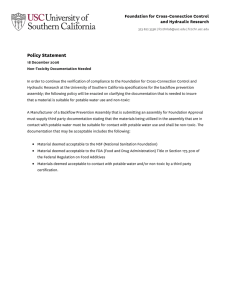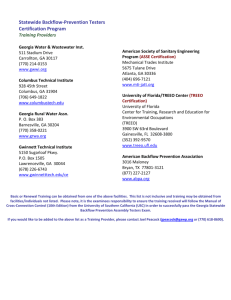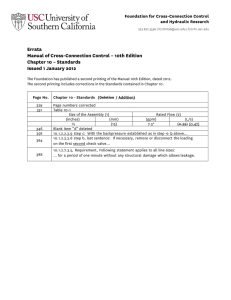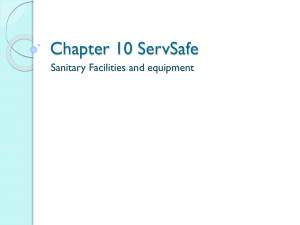Industrialized Water
advertisement
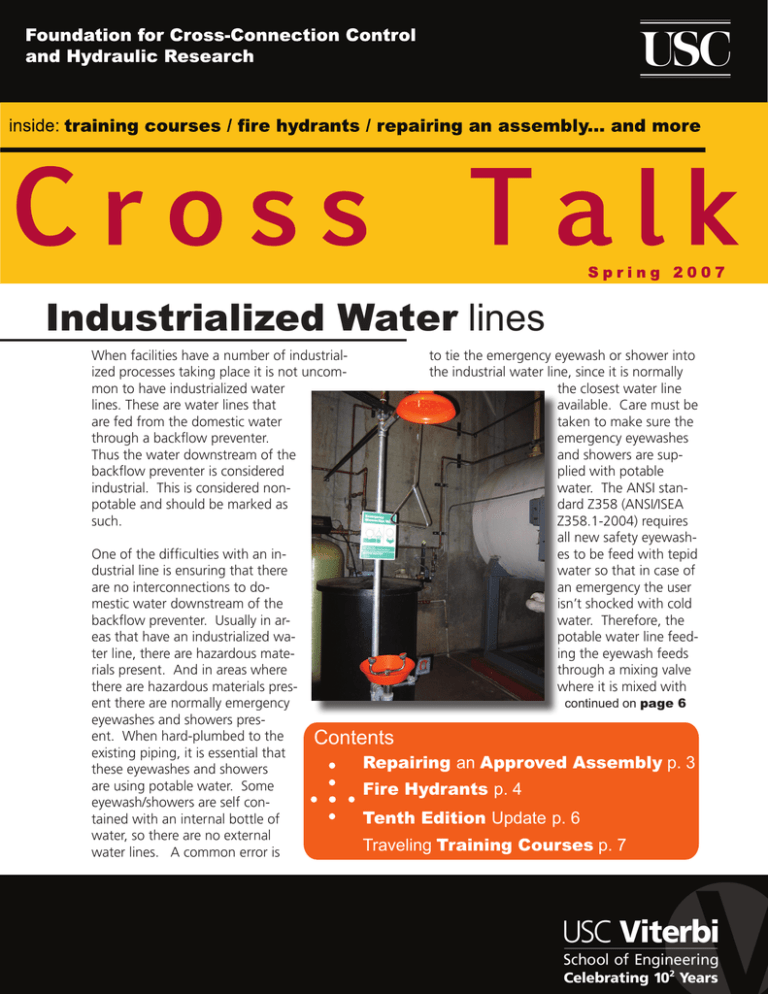
Industrialized Water lines When facilities have a number of industrialized processes taking place it is not uncommon to have industrialized water lines. These are water lines that are fed from the domestic water through a backflow preventer. Thus the water downstream of the backflow preventer is considered industrial. This is considered nonpotable and should be marked as such. One of the difficulties with an industrial line is ensuring that there are no interconnections to domestic water downstream of the backflow preventer. Usually in areas that have an industrialized water line, there are hazardous materials present. And in areas where there are hazardous materials present there are normally emergency eyewashes and showers present. When hard-plumbed to the existing piping, it is essential that these eyewashes and showers are using potable water. Some eyewash/showers are self contained with an internal bottle of water, so there are no external water lines. A common error is to tie the emergency eyewash or shower into the industrial water line, since it is normally the closest water line available. Care must be taken to make sure the emergency eyewashes and showers are supplied with potable water. The ANSI standard Z358 (ANSI/ISEA Z358.1-2004) requires all new safety eyewashes to be feed with tepid water so that in case of an emergency the user isn’t shocked with cold water. Therefore, the potable water line feeding the eyewash feeds through a mixing valve where it is mixed with continued on page 6 Contents Repairing an Approved Assembly p. 3 Fire Hydrants p. 4 Tenth Edition Update p. 6 Traveling Training Courses p. 7 Foundation Membership The Foundation’s Membership Program provides many benefits to the Members of the Foundation. These include: a twenty-five percent discount on manuals, twenty percent discount on Foundation Training Courses for any employee of the Member company/organization, the List of Approved Backflow Prevention Assemblies, printed quarterly, and access to the up-to-the-minute version of the List for those Members with Internet access. Members are encouraged to call the Foundation with technical questions. The Foundation’s Engineering Staff is available to assist members with the various aspects of field testing backflow preventers, installing backflow preventers and administering their cross-connection control program. Below is a list of those who have become Members of the Foundation this past quarter: IBIS Kodiak, City of AAA Backflow Livingston, City of Advanced Hydronics Michael J. McGann Algona, City of Norwalk Municipal Water Dept. City of Aqua Backflow, Inc. Pipe Cutter Plumbing LLC Aqua-New York Water Piping Industry Apprenticeship Board Bluewater Backflow Services Poormans Heating & A/C California Plus Engineering, Inc. R. Essay Plumbing and Heating Damon S. Williams Associates Same Day Backflow Testing DARSPEC Santa Maria, City of Dexter Wilson Engineering, Inc. Steve Herres EcoSystems Design & Development Suarez Engineering Edward Vertucci Town of Addison, Texas Got Sprinkler Repair? Water Connection, The Hemet Valley Backflow Service Wolfe Landscape Services, Inc. HR2 Inc. Cross Talk is published by the Foundation for Cross-Connection Control and Hydraulic Research at the University of Southern California for Foundation Members. Limited additional copies are available to Members upon request. 2007 © University of Southern California. All rights reserved. Cross Talk SPRING 2007 Page 2 Repairing an Approved Assembly The List of Approved Backflow Prevention Assemblies is a critical tool for many in the cross-connection control field. The Foundation’s evaluation of the assemblies in the laboratory and also in the field continues to make it one of the more rigorous approval processes. Assemblies that successfully complete the laboratory and field evaluation are granted Approval. Foundation Approved assemblies have shown that they meet a very high standard. Therefore, it is crucial that the Foundation have guidelines on how an assembly, which appears on the List, be repaired. To maintain the Foundation’s approval it is required that all backflow prevention assemblies be repaired with originally manufactured spare parts. For example, a Double Check Detector Assembly (DCDA) with a malfunctioning bypass assembly can be repaired only with originally manufactured spare parts. If the originally manufactured spare parts (OEM parts) are not available, the DCDA would need to be replaced entirely. Shutoff valves can be a common component in need of repair. If a DCDA has a bad No. 2 shutoff valve, the shutoff valve can be replaced with an identical brand, or a shutoff valve listed as acceptable for that particular assembly. Every backflow prevention assembly has been tested and approved with specific shutoff valves and that information can be found in the “shutoffs” column of the List. Please note that each assembly has been assigned certain shutoff valves. The use of any shutoff valve on a specific assembly, other than those listed for that specific assembly invalidates the Foundation’s approval. Removing parts or modifying an assembly is not acceptable. For instance, if an individual would want to remove the bypass from a DCDA but still continue to use the mainline assembly that would invalidate the Foundation’s approval. This decision is based on the fact that the assembly has changed from the time it was evaluated and the Foundation can no longer consider it an approved assembly. Periodically there are bypass assemblies approved with a detector assembly (either DCDA or RPDA), which is no longer being manufactured. They are listed on the List as having “spare parts only.” This means originally manufactured spare parts are still available from the original equipment manufacturer, even though the entire assembly is no longer being manufactured. When these bypass assemblies, which are listed as “spare parts only,” have need of repair, it is possible to repair them with OEM parts. However, it is not possible (in all likelihood) to replace the entire bypass assembly, since it is no longer being manufactured. Some field personnel have contacted the Foundation wishing to use a bypass assembly other than the assembly approved with the detector assembly. This would invalidate the Foundation’s Approval. If the body of the bypass assembly is actually damaged and the bypass assembly cannot be repaired, then the entire DCDA would need to be replaced with a current Foundation approved DCDA assembly. The Foundation encourages anyone with any problems or questions about repairing an approved assembly and maintaining its approval to contact the Foundation’s office by phone or e-mail via the Foundation’s website (www. usc.edu/fccchr). g Cross Talk SPRING 2007 Page 3 Fire Hydrants and Cross-Connectio There are several cross-connection control issues, which may involve fire hydrants. 1. Fire Hydrants may be installed at the end of a long leg of piping, giving opportunity for the water to stagnate in the leg of piping. 2. Fire hydrants are often used to provide water at construction sites 3. Some fire hydrants are dry barrel hydrants, which drain into the surrounding ground area once closed. Fire Hydrants and the End of a Piping System. Construction Meters Fire hydrants installed on public water distribution systems are not usually installed at the end of a long leg of piping and would, therefore, rarely create the potential for stagnant water in the potable system. However, it is not uncommon for private hydrants to be installed within a property that needs the hydrants for fire protection. In these cases, it is possible that the private hydrant would be installed at the end of a long leg of piping, which would create a situation where the water could be come stagnant. This is especially true on large properties, which may have buildings on the property located away from the public water supply’s water distribution system. In this case, most water suppliers require backflow protection on the water line feeding the private hydrant. Double Check Detector Assembly Cross Talk SPRING 2007 The water in the piping downstream of the backflow preventer may become stagnant, however, the water supplier’s water has been protected by the backflow preventer. Normally there will not be any other water lines tied into the leg upstream of the fire hydrant. The only use of the water in the stagnant line would be for fire fighting purposes and the potability of the water would not be a concern at that point. Page 4 Water suppliers regularly issue construction meters. These are water meters, which are usually attached to a fire hydrant allowing water to be used and metered at construction sites. Water is, typically, taken from the meter to the point of use via temporary piping or a fire hose. Construction Meters: When construction meters are issued, hazard is unknown. it is not really possible to conduct a site survey of the construction site to determine if there are any cross-connections. Since the construction site is a dynamic location with constant changes in the use of water, it is necessary to require backflow protection at the fire hydrant. Many water suppliers require backflow protection with each construction meter issued. Normally, a reduced pressure principle assembly (RP) is required since the degree of hazard is unknown. Many cross-connection control regulations require that backflow preventers be tested immediately after installation, repair, or relocation. Does this mean that every time a construction meter is installed, the backflow preventer installed with it needs to be tested? This is exactly what some water suppliers do. Although it may seem that testing the assembly every time it is moved is excessive. It is necessary to ensure that the assembly is on Control actually working before it is put into service. Some agencies have the backflow preventers tested after their use with the construction meter has been completed. This way the backflow preventers have been tested and are ready to go back out in the field. Contractors will normally make arrangements with the water supplier to use a specific fire hydrant at the construction site, then the water meter and backflow preventer will be used for the entire time of the construction project. Some agencies An RP is required since the degree of will install the water meter and backflow preventer arrangement on the hydrant and perform a field test, while others will require the contractor to check out the arrangement, pay a deposit, and install it themselves. The water purveyors will then need to verify that all construction sites are indeed using this arrangement properly. Penalties or fines may be levied if the construction sites are not following the temporary service requirements. To summarize, when construction water meters are used, a backflow preventer should be installed with the meter and the backflow preventer should be tested each time it is installed at a fire hydrant. Fire Hydrants Fire hydrants themselves aren’t necessarily a cross-connection. A wet barrel fire hydrant is normally pressurized with water. When hoses are attached to the hydrant for fire fighting purposes, this does not present a problem since there are no cross-connections. Of course, there is the possibility that the hy- drant could be cross-connected to some nonpotable substance through the fire hoses. But, normal use of a fire hydrant should not present a cross-connection problem. The dry barrel fire hydrant, may however, present a problem. A dry barrel hydrant is normally used in areas where freezing is a concern. When the hydrant is closed, the barrel itself is drained. When the barrel is drained the barrel is opened up to the surrounding ground to drain the water from the barrel. This opening to the surroundPressurized Dry Barrel Fire Hydrant ing area may be considered a cross-connection because of the contaminated water around the exterior of the hydrant. This is especially a concern when the groundwater levels are above the level of the drain in the hydrant. Although some weather conditions may dictate that a dry barrel hydrant is used, the administrative authority should be aware of the cross-connection potential with this type of fire hydrant. g Dry Barrel Fire Hydrant: When the hydrant is closed, the barrel itself is drained. Cross Talk SPRING 2007 Page 5 Tenth Edition Update- New Chapters The Manual of Cross-Connection Control, Tenth Edition is nearing completion, thus the Foundation would like to introduce and explain a number of new chapters that will be included. Incorporated into the Tenth Edition manual will be a chapter on the History of Cross-Connection Control. The chapter will encompass and discuss the first reported cross-connections and follow the evolution of cross-connection control. A new chapter on Hydraulics will be included in the Tenth Edition. The Hydraulics chapter will consist of the science and technology behind the transportation of water through pipes. Additionally, the Tenth Edition will include a chapter dedicated to Cross-Connection Control Surveys. The chapter will be key for anyone who is responsible for administering a cross-connection control program. The chapter will provide those responsible for a program with invaluable information for identifying potential cross-connections and explaining what steps should be taken to remedy the situation. The Tenth Edition will also include two chapters, which will be instrumental in helping the cross-connection control program specialist. Chapter six will cover Facilities, since it is not possible to cover every possible facility that the program specialist may encounter, the facilities are grouped into major categories. Each of these categories is described and a list of equipment that may be expected to exist at these facilities will be included. Chapter eight, Equipment, is a listing of various pieces of equipment that the program specialist may encounter on a site survey. This chapter will discuss a variety of equipment and inform the program specialist, “what it is,” how it works,” and where it’s used.” As the release date of the Manual of Cross-Connection Control, Tenth Edition nears; the Foundation encourages everyone to visit the Foundation’s website (www.usc.edu/fccchr) for the latest details. g Industrialized Water lines continued... domestic hot water to achieve the desired temperature. If there is a mixing valve, the hot water must be “domestic” hot water, and not “industrial” hot water. If industrial hot water is used, then there is a direct cross-connection at the tempering valve. Another common mistake made in industrial facilities has to do with the eyewash. Although an eyewash is normally in an area of the building that has hazardous materials, the eyewash itself does not present a cross-connection hazard. Many assume that any eyewash requires backflow protection to prevent the water from flowing into the potable system from the eyewash. This is not the concern. The concern is to make sure that the eyewash is supplied with potable water, even though it may be located in an area that has industrial water lines. An RP is required either after the water main or at the cross-connection for the industrial line or both. Cross Talk SPRING 2007 Page 6 Traveling Training Courses The Foundation has scheduled two training courses outside of the Los Angeles area for this coming calendar year. In the past, the Foundation has taken the training courses, the Course for the Training of Backflow Prevention Assembly Testers and the Course for the Training of Cross-Connection Control Program Specialists, on the road to places like Ohio, Nevada, Arizona, and Hawaii. This year the Foundation has scheduled a Tester training course for June 25-29 in the city of Redding, which is located in Northern California. Attendees of the course will receive hands-on instruction on how to test a backflow preventer. The course is designed to train the attendees in the ins and outs of field-testing the pressure vacuum breaker, the spill-resistant vacuum breakers, the double check valve assemblies and the reduced pressure principle backflow prevention assemblies. The Foundation has also schedule an out of state course this year. Beginning on August 6th through the 10th the Foundation will be in San Antonio, Texas for a Specialist training course. The course is designed to train those who might be involved in administrating a cross-connection control program. Subjects covered in this course include: policies and procedures, rules and regulations, record keeping, public relations, plan check and site surveys. The Foundation encourages everyone who is interested in Cross-Connection to attend one of these course that might be in your local area. If you are interested in hosting a course the Foundation recommends you visit its website, www.usc. edu/fccchr, and click on the “Frequently Requested Documents” link that can be found on the homepage below the Information sub-heading. g Plumbing potable water into the area where industrial water is used, can present another problem. The industrial water and the potable water could become interconnected. If a new piece of equipment is added that requires a water line, it is possible that the domestic water line may be used to supply the industrial equipment. If there is no backflow protection at the service connection of the facility, but only on the industrial line, this interconnection would endanger the water supplier’s distribution system. It is, therefore, very important to make sure that the potable and industrial water lines are clearly marked. In some cases an industrial water line may not be used, but individual pieces of equipment will be protected with the appropriate type of backflow protection at the point of water use. This would not only protect the domestic system should there be an interconnection, but it would also protect the various pieces of equipment from cross-contamina- tion. If, however, a new piece of equipment is added without backflow protection, then the internal water line would be subject to contamination as well as the public water supply. Where there is an industrial water line, it is not uncommon for there to be a backflow preventer at the service connection in order to ensure the quality of the water supplier’s distribution system regardless of the backflow protection at the industrial water line, or at the various points of water use. This is to ensure the protection of the potable water distribution system. Regardless of the backflow protection at the various points of water use, the water supplier will want to protect their water distribution system. Since, the water supplier cannot be assured that the internal plumbing configuration will remain the same as it was during the site survey, protection at the service connection is often required. g Cross Talk SPRING 2007 Page 7 Training Courses Tester Course Los Angeles, CA 14-18 May 2007 Redding, CA 25-29 June 2007 Los Angeles, CA 9-13 July 2007 Specialist Course Los Angeles, CA 23-27 July 2007 San Antonio, TX 6-10 August 2007 Foundation for Cross-Connection Control and Hydraulic Research University of Southern California Kaprielian Hall 200 Los Angeles, California 90089-2531 Upcoming Events CA-NV AWWA Spring Conference Las Vegas, NV 17-20 April 2007 California Env. Health Association Annual Educational Symposium Sacramento, CA 23-27 April 2007 ABPA Annual Conference and Tradeshow Reno, NV 30 April- 2 May 2007 Contact Information Phone: 866-545-6340 Fax: 213-740-8399 E-mail: fccchr@usc.edu Website: www.usc.edu/fccchr First Class US Postage PAID University of Southern California
